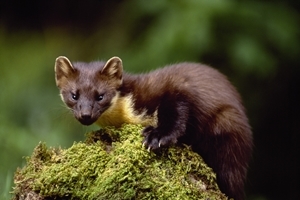Pine marten
 The pine marten (Martes martes), sometimes also known as the marten cat, sweetmart or sweet marten, is aptly named, as it is most frequently found in coniferous forest and it is seldom seen out in the open. It used to be a common species found across the country wherever large tracts of woodland occurred.
The pine marten (Martes martes), sometimes also known as the marten cat, sweetmart or sweet marten, is aptly named, as it is most frequently found in coniferous forest and it is seldom seen out in the open. It used to be a common species found across the country wherever large tracts of woodland occurred.
However, the clearance of woodlands, together with predator control, had a devastating effect on the pine marten population, and by 1915 this species was confined to just a few of the more remote areas across Britain and Ireland.
Today, populations are expanding in number and range in Scotland and Ireland. In England and Wales, however, the population has not recovered from its decline, and pine martens live at very low densities with a very restricted distribution. In England, pine martens have recently been recorded in Shropshire and the New Forest, and occasional records have come from the Lake District, Northumberland and the North York Moors.
Pine martens also occur throughout mainland Europe and parts of Russia, stretching from the Ural Mountains in the east to Ireland at the western edge of the species’ global distribution. They can also be found in parts of the Middle East and on the islands of Sicily, Corsica and Sardinia.
Pine martens come from the Mustelidae family, so are related to weasels, ferrets, polecats and otters. They have a rich, chestnut-brown body colour, with a characteristic pale yellow ‘bib’ on their chin and throat, and support a long, bushy tail. They have rounded ears, relatively short legs (certainly in comparison to their long bodies) and are about the size of a smallish cat. They can potentially live for about 8-10 years.
Martens have territories that vary in size according to habitat and food availability. For males, these are usually about 10-25 square kilometres and for females about 5-15 square kilometres.
Young pine martens, which are known as kits, are born during March and April. Typically, two to three kits will be born, each weighing less than 30g. The kits stay in the den for about six weeks and are totally dependent on the female. Kits will then start exploring the area around the den and will stay with the female for at least six months.
Pine martens are extremely agile and wonderful climbers, helped by their long tail, which they use constantly for balance. They have a wide and varied diet, which is chiefly carnivorous, catching birds; amphibians; mammals such as rodents, rabbits and grey squirrel; and, during winter months, they will also feed on carrion. They have a great liking for eggs and nestlings, but will also eat fungi, fruit and berries. In fact, in Scotland, bilberries can make up to 30% of a pine marten’s summer diet, resulting in its droppings turning blue in colour!
The fact that pine martens eat grey squirrels has attracted much attention of late. If the marten made a comeback, might it drastically reduce numbers of the non-native grey? Research has suggested that pine martens prey on grey squirrels rather than red squirrels, because they are slower and spend more time on the ground than reds, making them a much easier target.
In 2014, the Vincent Wildlife Trust, in consultation with and support from various conservation bodies (including the GWCT), launched its Pine Marten Recovery Project. The aim of the project is to restore self-sustaining populations of pine martens to England and Wales. The first step was completed in autumn 2015, with the translocation of 20 pine martens from Scotland to mid-Wales, and further translocations of 19 pine martens took place in autumn 2016.
Under the Wildlife and Countryside Act 1981, the pine marten is protected from a lot of human activity. It’s illegal to intentionally or recklessly kill, injure or take wild pine martens, destroy their shelters or sell them, without a licence.
Interestingly, however, the pine marten is listed as ‘Least Concern’ under the International Union for Conservation (IUCN), in view of its wide distribution, large population, occurrence in a number of protected areas, tolerance to some degree of habitat modification, and because it is unlikely to be declining at nearly the rate required to qualify for listing even as ‘Near Threatened’. Indeed, the population is stable to increasing, after former steep declines in some of its range.
In Russia, martens are more frequently turning up in cities such as Moscow, sometimes emptying out rubbish bins, and are considered to be a major source of rabies to humans, after dogs and foxes. This, coupled with their liking for birds, eggs and nestlings, should mean that measures in this country are put in place when introducing a species, such as the pine marten, back into areas from which they have disappeared. These measures would enable control measures to be taken, should the species increase rapidly and start to impact on other declining species.
That said, how wonderful it would be to see this species spread back across the Welsh and English countryside once more, including Northamptonshire, from which the poet John Clare wrote in the 19th Century: “The Marten cat, of courage good, he keeps one track and hides in lonely shade, where print of human foot is never made.”
Peter Thompson
Advisory
Read more from Peter Thompson at his blog.
Photo credit: Laurie Campbell